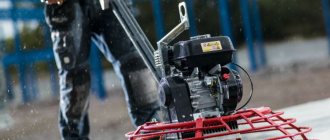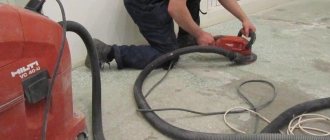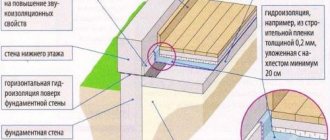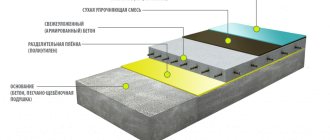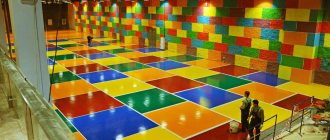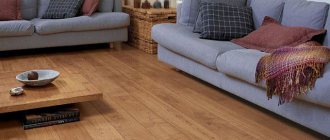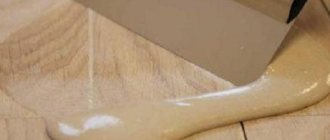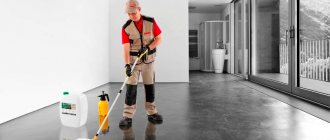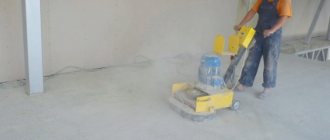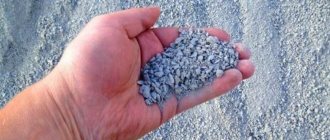Why does a concrete floor need protection?
For the implementation of highly loaded industrial floors, concrete is most often used . The material is relatively cheap, characterized by high strength, coating construction technologies are quite effective, studied and simple.
The name itself (from English top - top) suggests that this technology concerns only the surface of concrete
Along with its advantages, concrete also exhibits disadvantages, which are caused by increased porosity and insufficient tensile strength. This causes the surface to begin to wear out and become dusty during use.
Cement dust appears due to the release of salts to the surface. Plus, the weak top layer , represented by various contaminants, cement and filler, is destroyed. This is why almost all concrete floors generate dust. To combat such manifestations, the surface layer is hardened. One of the most effective methods for creating long-lasting concrete floors is topping.
What is a topping floor?
When laying the mixture during compaction and leveling, special additives are scattered over the surface in an even layer, which increase the characteristics of the concrete surface, such as:
- strength;
- resistance to mechanical stress;
- resistance to temperature changes;
- ease of use;
- wear resistance;
- hygiene.
Cement, pigments, fillers made of quartz, basalt, corundum, and metal can be used as additives. Using a special paddle machine, sometimes called a “helicopter,” additives in the form of a dry mixture are rubbed into the upper, slightly damp layer of concrete. In those places where the machine is not able to grout the surface, this work is performed manually.
When pressed with the blades, the smoothed mixture acquires a shiny and perfectly smooth surface. Despite the fact that the thickness of the hardened layer is small, only 2-3 cm, its strength is such that it can withstand the movement of large mass mechanisms, both rubber and tracked. At the same time, the topping floor can have different colors and shades, and its scope of application expands significantly. Such floors can be installed in garages, indoor and outdoor parking lots, in large halls of airports, train stations, shopping and entertainment centers, factory floors and in the chambers of industrial refrigerators.
Advantages and disadvantages of topping floor
First of all, it must be said that this technology for constructing a surface with a reinforced top layer is advantageous in comparison with other types of floor coverings that have the same technical characteristics. Besides:
- Wear resistance and impact resistance increases by 4-7 times.
- The strength of the coating can withstand a compressive load of at least 80 MPa.
- The work is done quickly, when the application of dry additives is possible 3-4 hours after laying the main layer of concrete.
- Thermal resistance.
- The maximum service life of this floor covering increases.
- Concrete industrial flooring becomes as attractive as possible, given the wide palette of colors.
- Good vapor permeability.
But, as usual, nothing is ideal in the world, so let’s talk about the disadvantages of a topping floor where only dry additives are used. This:
- High demands on the quality of the concrete mixture; if unsatisfactory, cracks may form.
- Not applicable to old concrete surfaces.
- It is impossible to completely get rid of cement dust.
- Insufficient resistance to acids, solvents, fuels and lubricants.
- Low tensile strength and bending moment.
Some shortcomings can be eliminated by using various impregnations for concrete floors.
Types of impregnations for concrete surfaces
The properties of a concrete coating can be improved by using polymer impregnations, which gives the surface additional resistance to dust formation, moisture absorption, and abrasion resistance. In addition, the top layer formed by the polymer film well protects the internal structure of concrete from mechanical influences.
The effect of impregnation is that the liquid polymer mass penetrates the concrete structure, filling all the pores. The more pores are filled with liquid and the deeper it penetrates into the concrete body, the more effective this procedure will be.
To prevent the concrete surface from collecting dust, dust-removing impregnations are used in the form of compositions based on acrylic, perchlorovinyl and other resins dissolved in organic or aqueous solvents - Praspan, Sika, LEVL Top, Master Top and others.
Impregnations designed to maximally strengthen the top layer of concrete are made on the basis of epoxy resin or one-component polyurethane polymer, which hardens in a humid environment. Such compositions are a low-viscosity liquid that can penetrate quite deeply into the concrete layer, thereby creating a top concrete-polymer coating.
Reinforcing the top layer of concrete is inexpensive, and similar impregnations can be used both on new surfaces and on old concrete screeds. But, despite the high properties of polymer materials, such reinforced (topping) floors require repair after time.
What is topping
Topping is a composition designed to strengthen and protect concrete. It works to strengthen the surface layer . The additive contains Portland cement and filler, dyes and mineral pigments. Essentially, it is a mixture of components with increased strength, hardness, and abrasion resistance.
It is enough to scatter the material over the surface of a freshly laid base, smooth it with a trowel and sand it several times, which will provide the required texture (grainy or mirror-like). This is the most common principle of dry-on-wet operation - DTW.
In some cases, a different technology is used - “wet on wet” WTW, when the hardener is pre-mixed with water and applied to fresh concrete . “Wet on dry” WTD - concrete is milled, primed, topping is mixed with water, applied and rubbed.
After completion of the work, the floor is additionally treated with protective impregnation or sealer. The compositions, penetrating into the topping, help compact the structure, protecting against the penetration of chemical compounds and moisture, ensuring the preservation of external properties.
Classification of industrial toppings-strengtheners
The composition of the system is selected based on the loads that the floor will experience during operation . For example, to protect against excessive mechanical loads, a topping with a metal filler (stainless) is used. If it is necessary to increase resistance to physical and chemical influences, quartz-corundum mixtures are chosen. In addition to a purely functional purpose, hardeners give the surface an aesthetic appearance, but without any special highly decorative properties.
Metal toppings
These are ready-to-use dry strengthening mixtures formed on the basis of highly active Portland cement and special metal fillers. The material surpasses heavy concrete class B35 in wear resistance by 6-8 times, ensuring a long service life and almost complete dustlessness .
Peeling of the metal topping during operation is excluded
The treatment increases the density of the base, enhances impermeability to aggressive substances and water, enhancing frost resistance, resistance to oils and fuels and lubricants. The metal topping is in close contact with the concrete, forming a single whole with the base.
The finished floor is produced in one technological cycle , which reduces work time, costs and allows the facility to be put into operation as quickly as possible.
Restrictions on the use of metal reinforcement in industrial floors:
- the surface is exposed to intense moisture. This can cause corrosion of the metal filler, causing rust spots to appear on the floor;
- floors are affected by salts, acids, and other substances that are aggressive to concrete;
- This is not an option for substrates with high requirements for decorativeness and hygiene.
Topping with metal filler is designed to strengthen new concrete floors with high impact and abrasion loads.
Quartz
Strengtheners are presented in the form of a dry construction mixture based on high-quality cement with the addition of quartz sand and plasticizers. Concrete is strengthened 2 times, which is optimal for industrial floors with medium loads .
The material is in demand for strengthening floors in workshops, garages, cargo storage areas, parking lots, basements, warehouses, corridors, and loading platforms.
The composition does not require a leveling layer and is available in a wide range of colors. The base becomes more resistant to oils and freeze-thaw cycles.
Unlike metallized toppings, it is used on new and old substrates.
Restrictions on the use of quartz hardeners:
- floors that may be exposed to salts, acids and other substances aggressive to concrete;
- floors where maximum impact resistance and wear resistance are required.
Corundum toppings
The material is used to strengthen concrete bases with requirements for high resistance to abrasion, impact loads, absence of rust and stains.
The base treated with topping is 4-5 times more wear-resistant than heavy concrete B35, removing dust and increasing the service life of the floor . Concrete is compacted and becomes practically impenetrable to water and aggressive substances, including oils and fuels and lubricants.
The material is optimal for use in industrial buildings: warehouses, mechanical workshops, workshops with electronic equipment. Efficiency extends to parking lots, loading docks, sidewalks, and garages.
Restrictions on the use of corundum hardeners:
- floors with high requirements for hygiene and decorativeness;
- floors where higher impact resistance during operation is required;
- floors exposed to salts, acids, and other aggressive substances.
Corundum topping is a dry hardener containing highly active Portland cement and specially selected corundum fillers
Advantages of topped surfaces
Thanks to the simple construction technology, topping floors are popular both in the construction of new buildings and in the reconstruction of damaged coatings.
Advantages of reinforced concrete surfaces compared to conventional, untreated ones:
- abrasive wear is reduced to 0.01-0.06 mm according to the BCA test;
- abrasion is no more than 6-9 g/cm³ in Taber tests;
- the coating acquires waterproof properties;
- laying is carried out at high speed;
- affordable price - 1500-2000 rubles. for 1 m² together with a screed device 8 cm high;
- on the tenth day the floors can be used, and on the 28th day they can be fully loaded;
- service life increases 4-5 times;
- simple technology for restoring old damaged coating.
Colored topping for concrete additionally contains pigments that penetrate deeply into the surface when the mixtures are rubbed in. The coatings are tinted in a variety of colors - white, pink, brown, gray, green and their shades. An abrasion-resistant decorative layer is formed. Varnish treatment creates gloss. With this finishing you can give the floors the appearance of a mosaic panel.
Advantages of concrete toppings
After treatment with topping, the resistance of an industrial floor to mechanical damage increases significantly. This ensures long-term maintenance-free operation, as there are no potholes or chips.
Other advantages of the system are:
- if the hardener is applied to M350 concrete, the tensile strength in the upper layer will reach M800. This significantly extends the life of the floors;
- the base does not generate dust, is resistant to gasoline, oils, and diesel fuel;
- choice of texture – mirror, smooth, grainy;
- reinforced flooring is easy to use and easier to keep clean;
- After high-quality processing, the surface acquires antistatic characteristics and becomes spark-free.
Advantages
The main advantages of an industrial concrete floor with topping include:
- increased strength;
- ease of care;
- aesthetic appearance;
- exceptional wear resistance;
- waterproof;
- complete absence of dust;
- low installation time;
- long service life;
- avoiding peeling of layers;
- antistatic properties;
- resistance to heat;
- reduction of concrete costs;
- rich color palette;
- affordable price.
The affordable price makes topping coatings accessible to many. The average cost of 1 m² in Moscow is 1,060 rubles. We are talking about a height of 8 cm.
The disadvantages of concrete topping are:
- seams;
- low resistance to chemical influences;
- poor maintainability.
Scope of application
Modern reinforcements are used in areas with high pedestrian and mechanical load. First of all, these are various production facilities, warehouses, parking lots, and parking lots.
The restriction applies to places where spills of acids and alkalis occur - this requires the installation of other industrial floors. Plus, to increase the moisture resistance of the topping floor, impregnations should be used. But it is necessary to understand that subsequent processing will not allow repair of peelings and abrasions. The damaged hardened layer from the area will have to be completely replaced.
Where are they used?
Concrete floor topping is actively used in various rooms:
- warehouses;
- refrigeration chambers;
- industrial facilities;
- parking lots and parking lots;
- production workshops;
- exhibition complexes and shopping centers;
- swimming pools and sports grounds;
- objects that do not have flooring requirements.
Thanks to a host of benefits, topped concrete floors have gained popularity. They are durable, hygienic and have almost no flaws.
Before the advent of such coverage, the old technique was common. The builders used ironing, which consisted of scattering cement over the surface and rubbing it.
Features of the technology
Adding a hardener is a labor-intensive and complex process that requires strict adherence to technology . Deviation from the principle of conducting work threatens the formation of critical defects. The cost of eliminating defects is often higher than adding topping from scratch. Work begins at a strictly defined time, otherwise the water-cement ratio will be disrupted and defects will inevitably occur.
An integral part of the technology is the method of dosed application of the dry mixture . This promotes uniform redistribution of moisture, otherwise it is impossible to evenly saturate the entire volume. Protecting the top layer after grouting is the final touch in any strengthening of an industrial floor with topping; the nuances of impregnation are discussed above.
This stage can be implemented in three ways:
- the use of polyethylene film is the oldest method that demonstrates maximum savings. The method is not as effective as the others, but still provides protection for the top layer;
- applying sealers (protective varnishes) is a modern, effective option, convenient, inexpensive, and fast. The material is applied immediately after grouting;
- applying dust-removing and strengthening impregnations is the most high-tech method. The floor receives additional dust removal and strengthening, plus there is no aging effect on the surface. But, this again requires strict adherence to technology.
The distribution of the mixture should be as uniform as possible, with a flow rate corresponding to the design loads
What are the features of topping floors
High-strength flooring is formed after rubbing special dry mixtures into concrete. Depending on the future load, the type of suitable additives is selected, which may contain:
- quartz sand;
- metal elements;
- corundum particles.
The scope of application of topping floors is expanding due to the fact that dye can be added to it. In this way, a decorative coating is made that will highlight the advantages of the room or area.
Our employees themselves select the appropriate type of additive, depending on the object, and the price for creating a topping floor does not change from what was previously agreed upon.
It is recommended to buy topping coating from trusted companies, which include Basfor. We provide services for creating reinforced floors in the cities of Kazan, Samara, Ufa, Ulyanovsk. Leave a request on the website or call contact numbers for consultations. The master will provide a preliminary estimate.
Metal topping technology
The dry hardener is applied to the freshly laid concrete base and rubbed in using concrete finishing machines.
Preparation
Basic requirements for the implementation of the technology:
- ambient air temperature, base – not lower than + 5 degrees;
- at temperatures above + 25 degrees and humidity below 60%, in conditions of lack of protection from the sun and drafts, concrete quickly loses moisture and dries, which will not allow for complete grouting of the mixture. If the working conditions are such, special materials are used to reduce water evaporation (after each technological operation);
- the type of base, location of reinforcement, preparation, concrete class, slab thickness are determined by building codes, work technology and design.
Base requirements
When laying the base, high-quality concrete with the characteristics laid down in the project is required. The percentage of air contained in the mixture is not higher than 3%. Concrete should not contain air-entraining additives, salt water, or calcium chloride. It is acceptable to use hyperplasticizers to reduce the risk of shrinkage cracks. For heavy loads, concrete class is B30 (M400), for light and medium loads - B25 (M350).
Concrete is poured until the finished floor level is reached and compacted with vibrators or vibrating screeds. After compaction, leveling is carried out using control slats and rules to the appropriate level.
Pre-grouting
When the concrete begins to withstand the weight of the trowel and a person, preliminary grouting is carried out. The work involves removing the dried crust of cement laitance and squeezing water onto the surface. Near the junctions, the base is processed first, since it dries faster there.
Areas that cannot be processed by machine are manually rubbed with trowels. Grouting is carried out until a homogeneous surface is obtained and the mixture is completely saturated with cement laitance.
First application of hardener
Using distribution trolleys, about 5% of the topping is applied to the floor, trying to achieve the most uniform layer possible. First of all, the mixture is applied to the area near columns, doorways, walls and other structures.
On control - it is strictly forbidden to wet the hardener and add water . Otherwise, air bubbles and peeling will form between the concrete and the topping layer.
First grout
When the topping absorbs moisture, which is evident from the darkening of the layer, grouting is carried out using a concrete finishing machine with a disc. Work begins near the enclosing structures, columns, and doors. A uniformly mixed mixture should form on the surface, with complete saturation with cement laitance.
All toppings contain cement, which can cause irritation. Avoid prolonged skin contact and eye contact.
Second application of topping
After finishing the grouting, spread the remaining part of the hardener (35%) so that it has time to soak in the moisture of the base. When applying, control possible uneven application of the first dose of the composition.
Second and additional grout
After the topping has been impregnated with moisture, which can be seen by its darkening, they immediately begin to re-treat the surface with trowelling machines. If necessary, carry out the third and fourth grouting, if the hardener has not been properly rubbed into the surface of the base before (if the properties of the concrete mixture and time allow this).
Smoothing
After the base becomes harder and loses some of its shine, you can begin smoothing. The work uses a concrete finishing machine with blades installed with a minimum angle of inclination . With each subsequent smoothing, the angle of inclination of the blades is increased. The harder and drier the concrete, the higher the speed should be used.
The interval between approaches depends on the condition of the surface. The floor should not stain your hands, the surface should be matte. Upon completion of the work, a smooth mirror surface should be formed.
Under control - in windy and dry conditions, the work is carried out as quickly as possible , which will allow obtaining the correct floor structure. Any delays may cause problems. Do not allow the blades to “burn” the base.
Care
Next, you can apply a concrete care product to the floor (spray or roller). The material is applied in one layer at the rate recommended by the manufacturer. Otherwise, the color uniformity may be lost and spots will form on the surface.
When the protection has dried, the surface can be covered with polyethylene film. This will eliminate physical damage, contamination, and staining, which cannot be removed later. The concrete is covered for 7 days.
Cutting and filling seams
When the concrete gains sufficient strength, the seams are cut (the filler should not crumble during cutting). For example, at a temperature of 18-20 degrees, the seams are made 2 days after pouring.
To prevent the destruction of the seam edges and the entry of debris and moisture into the grooves, a special sealant is poured (concrete moisture content no more than 5%, after 14-28 days).
Metal topping consumption
- for medium and light load – 4-6 kg/m²;
- for heavy and medium loads – 7.5-9 kg/m²;
- for very heavy loads – 9-10 kg/m².
Types of strengthening mixture
Strengthening mixture for concrete surfaces can be liquid or dry. Inorganic compounds that dissolve in water are a component of liquid topping. When applying the fixer to the floor, these compounds penetrate into all the pores of the concrete. Calcium carbonate then enters into a chemical reaction with free lime present in the solution structure. Ultimately, an insoluble compound is formed - this is the same hardener. Such special technologies are used in buildings with low humidity. Another advantage of the liquid product is that it can be used to coat both fresh and old concrete.
The main component of the dry concrete floor sealant is the same substance that is used in the production of concrete itself - Portland cement. When using topping, the process of adhesion between the fixer and the base improves, and the service life of the concrete coating increases up to 15 years. Only a fresh and leveled surface is covered with a dry mixture.
Quartz topping is the most commonly used.
There are various hardening fillers that improve floors. They are used in industrial premises, as the material evenly distributes the load on the floor. When applying a hardener to a concrete field, it can be put into operation no earlier than after a week:
- Quartz is a concrete mixture with the addition of purified quartz sand, which, with the help of coloring pigments, changes the appearance of the top layer of the concrete floor. Another advantage of this topping is its availability; in addition, it can withstand medium load conditions quite well. Using a quartz solution, the strength of the base increases by 1.5 times. Experts suggest using quartz mixtures in housing construction, and also advise using them in rooms with non-standard humidity (swimming pools, bathrooms, baths).
- Corundum is a hardener with the addition of corundum chips, cement, plasticizers and sand. Durable, damage-resistant material. Thanks to its properties, it doubles the reliability of the floor. This topping is used for floors that are subject to high loads. It is distinguished by its decorative effect and has a matte, very pleasant shine.
- Metallized. It consists of metal shavings along with concrete mortar. The advantage of this material is strength and durability. This type of topping is used in industrial enterprises where heavy machinery and equipment are installed. It provides excellent layer hardening under high operating loads.
The choice of topping directly depends on the parameters of using the floor covering. If the floor is not affected by various negative factors, then you can use quartz or corundum solution. Today there are more than ten varieties of topping shades, you can choose them to suit your taste.
Return to contents
Quartz topping technology
Before grouting, remove excess water from concrete using a spatula.
The material in powder form is applied to freshly laid concrete and rubbed into the surface with a trowel, followed by maintenance. The maximum result is achieved using impregnations.
Requirements for concrete mixture
It is necessary to use concrete with air entrainment of no more than 3%, cone settlement of at least 8 cm. Floors on which heavy transport will move are made of concrete of at least B22.5 (M300).
Laying, compacting and grouting is carried out according to the following principles:
- when laying, the finished floor mark must be reached (use a vibrating screed or deep vibrator);
- compaction is carried out along pre-arranged guides (check with a level);
- After compaction, the guides can be removed or left in place;
- leveling is carried out using the edge of a wooden board 2-3 m long, 2-3 cm thick;
- Grouting is carried out when the concrete can withstand the weight of the trowel disk;
- Grouting begins at the junctions and along the edges of the base.
First application of quartz hardener
Technological seams are strengthened. At least 70% of the calculated amount of topping is distributed across the floor using a special dispenser. It is necessary to ensure a uniform layer thickness .
First of all, they work in areas near walls and other structures. In hard-to-reach places, topping can be applied with a manual dispenser.
Implementation of the first grout:
- Grouting begins with a trowel with a disk at doorways, columns, walls, etc.;
- work begins as soon as the topping absorbs moisture (the composition will darken);
- it is necessary to try to step over the floor as little as possible, processing as large an area as possible while staying in one place;
- You should walk less on the freshly treated area. It is better to move around the edges of the new base, using wooden boards upholstered with soft material;
- If there are traces left on the floor, immediately eliminate them with another pass of the trowel.
Second application of quartz topping
Without a technological break, the remaining 30% of the composition is introduced so that it has time to become saturated with water. 10 cm are removed from the edges and walls of the card being filled in. If the area with the topping is not saturated with water on its own, in the case of quartz topping, additional moisture is allowed (you need to make sure that the manufacturer allows moisture).
Then immediately begin the second grouting (after darkening the hardener). The floor can be additionally treated with third and fourth grouts if the mixture has not been properly rubbed in.
First ironing
Work begins when the concrete loses some of its shine and becomes harder . Use a trowel with blades. A minimum slope is necessary, but the blades should not “burrow” into the base surface.
The harder and drier the concrete, the higher the speed of smoothing work.
After the floor has dried, it is smoothed again. The angle of inclination increases slightly. Further, when the base “shrinks”, it is processed again. At this stage the blades can be raised slightly. If additional manipulations are required, the angle of inclination of the blades is increased.
Seam protection and cutting
After a care product has been applied to the base and it has dried, it is isolated from the environment for 5-7 days. The seams are cut after the concrete has gained sufficient strength . As a rule, 24-36 hours after completion of work.
Consumption of quartz topping
- for medium-light load – 3-5 kg/m²;
- for medium-heavy load – 5-8 kg/m²;
- for colored bases, especially light ones – 6-8 kg/m².
Technology for creating liquid topping
The technological process is quite simple, but such repairs must be done very carefully and exactly follow the step-by-step technology. This is very important when the floor is made for industrial facilities, since a low-quality coating will very quickly become unusable and deteriorate.
The entire repair process occurs according to this plan:
- Let's prepare the base.
- Pour the concrete mixture.
- Apply topping for concrete.
- Cut and fill the seams.
So that you understand the whole process more deeply and clearly, we will describe each of the presented stages in detail, and you will be able to carry out or monitor your repair without any problems or hiccups.
Preparing the base
This stage is very important and allows you to get the best final result and significantly increase the quality and, accordingly, the service life of the coating. Concrete flooring can be laid either on the base of load-bearing slabs or on a bulk layer of crushed stone or flour. In this case, bulk coatings must be very compacted, their density must be at least ninety-five percent.
The installation is carried out strictly according to the level, and according to the beacons it is carried out using a rule that removes excess concrete mass.
If particularly heavy loads will be moved along the surface at industrial facilities, then the base must be reinforced. To do this, take a reinforcing mesh or reinforcement with a cross-section of six to ten millimeters.
In addition, it is imperative to use a water-retaining layer of film or special hydrobarriers. Industrial facilities require less of this addition, but its use in multi-storey buildings is mandatory.
A prerequisite is the installation of waterproofing. Waterproofing the floor is easy to do using the most ordinary thick polyethylene film.
Laying concrete
For such purposes, the best option would be to use special high-strength concrete, which in the end will additionally help strengthen the floor and extend its service life several times. On top of the base, five to ten centimeters of concrete are poured onto the reinforcing layer.
Industrial facilities can pour a layer of concrete and more than twenty centimeters to support the weight of trucks, KAMAZ trucks and other things. It is worth noting that there must be a gap between the base and the reinforcement, where cement will definitely get in, otherwise it will be of no use.
Compaction of the concrete mass is mandatory. Compaction can be carried out using a vibrator or by adding a superplasticizer to the concrete, which must be compatible with the topping.
The concrete is laid according to the principle of a conventional screed, after which it must be left to dry a little so that you can move on the surface without any problems. At this stage, the surface should already be perfectly flat and have an absolutely horizontal position without distortions or other defects. After the concrete base, liquid topping is poured onto the surface, which is subsequently sanded and processed to perfection.
Very often, before laying the topping layer, the concrete base is also ground, this is called primary grinding. In this case, the final sanding of the topping will be called secondary or finishing.
We apply protection
To increase quality and create more favorable conditions for the drying period, the finished surface is coated with a special product. It forms a very thin, invisible film that prevents the rapid evaporation of moisture.
Thus, the concrete dries more smoothly and cracks and microwebs do not form on the surface. After the film has been applied, until the surface has completely dried, you cannot move on it so as not to damage the coating.
The topping should be applied immediately after laying the concrete, without waiting for the drying process to begin, and then grouting is carried out using machines.
Cutting seams and installing seals
This stage is the final one and at the same time it requires the most time. It all starts with cutting the seams, about one or two centimeters wide, they are done one to three days after pouring the concrete. A period of one to three days is necessary for the concrete to dry so that it can be moved on without problems and further work done.
Seams are necessary for the surface to finally take its shape, sag and settle into place. The floor must be left in this position for twenty to thirty days.
After this period has passed, the seams are thoroughly washed, dust-free and dried. Then a special sealing tape is installed there, and it is secured with special sealants.
After the sealant has dried, the floor surface can be used for its intended purpose; industrial facilities can use the floor even when it has been standing for thirty days, but it is not recommended to run particularly heavy equipment.
Technology of applying corundum toppings
The material is applied to freshly laid concrete and rubbed in using concrete finishing machines.
Preparation
The temperature of the base and ambient air is not lower than +5 degrees. With humidity less than 60%, temperatures above +25 degrees, in the absence of protection from the sun and drafts, the top layer of the base quickly loses moisture, which will not allow for high-quality strengthening.
Only high-quality concrete mixture is used without additives that involve air or salt-based additives that provoke efflorescence.
Concrete class for light and medium loads is B25 (M350), for heavy loads B30 (M400). Laying, leveling, compacting, and preliminary troweling of concrete are carried out according to the principles described above. Since topping coatings are very sensitive to additives, it is best to carry out such work in the warm season, when manufacturers do not introduce anti-frost plasticizers into concrete.
First application of corundum topping
During the first application, 65% of the calculated amount of the mixture is applied to the floor. The layer must be uniform, which is achieved using distribution trolleys. Do not wet the topping or add water. Next, the first grouting is carried out after the topping is completely saturated with cement laitance.
Second addition of topping
Immediately after completion of grouting, the remainder of the hardener is immediately introduced. The material must have time to become saturated with moisture from the concrete. If necessary, compensate for the uneven distribution of the first part. After darkening, proceed to the second and subsequent grouts.
Smoothing, care and protection of the surface are carried out according to general principles.
Consumption of corundum topping:
- under significant loads: natural – 3-5 kg/m², colored – 5-6 kg/m²;
- under very significant loads: natural – 5-8 kg/m², colored – 6-8 kg/m².
Topping flooring technology
Toppings come in two types:
- Dry;
- Liquid.
For both cases, work is carried out using different technologies.
Dry method
Dry toppings are sold in the form of dry mixes in bags of 25, 50 kg. Application is carried out on freshly laid concrete. To work, you will need a topping trolley - a special distributing device that evenly scatters the powder. When installing industrial floors over large areas, manually spreading the mixture is very inconvenient and ineffective. To grind the surface, craftsmen use grinding machines with a large working disk.
- The poured concrete screed is rubbed over the entire area with a grinding machine. This is necessary to level the surface before it sets.
- Using a topping cart, apply the dry mixture in a volume of 2/3 of the total amount in the direction from the windows to the exit. As the powder is poured, it absorbs moisture from the concrete and the necessary crystallization reaction occurs.
- After applying the powder, the concrete is ground again. At this stage, the main leveling and filling of the concrete surface with a fixer occurs.
- Then distribute the remaining powder and allow it to soak.
- The grouting process follows again.
- After 2-3 days (sometimes 24 hours is enough), the frozen surface is cleaned with blade knives. The process is repeated 2-3 times until a mirror surface is obtained.
- According to the technology, it is necessary to cover the surface with curing - a solution that forms a thin film that prevents the evaporation of moisture from the stone while the concrete is hydrating. Curing is applied with a roller or spray method some time after finishing grouting.
- Expansion joints are cut to prevent cracking of concrete during shrinkage and hardening, which will finally stop no earlier than 28 days. The seams are filled with sealant.
The floor can be fully used after 28 days, when the finishing layer, which includes cement, has fully reached its design strength.
The average topping consumption per 1 m2 is 4.5 – 5 kg.
Liquid formulations
The advantage of liquid mortars is that they can be used on both a fresh screed and an existing floor. The effect will be equally good if the application is followed:
- It is necessary to ensure temperature conditions in the room +5…+35°С.
- The surface of the existing concrete coating is thoroughly cleaned of dust, if necessary, concrete or cement repair mortar is poured into cracks and potholes, and when working with a fresh screed, the mortar is polished.
- Liquid topping is applied to the prepared base with a roller or sprayer. It is necessary to monitor its absorption - the solution should be reapplied to areas where rapid absorption has occurred.
The layer thickness should be 2-3 mm above the concrete. Average consumption is 4-5 liters per 1 m2 of surface. The amount of absorption depends on the quality of the concrete base.
Within 1 day, the complete process of polymerization and compaction occurs, the surface becomes perfectly smooth, dense and durable. Excess is washed off with water. You can use the floor within 24 hours.
The undeniable advantages of liquid toppings are their versatility and fast hardening speed. However, for convenience you will have to pay an order of magnitude higher - the polymer material is more expensive than dry sealing powder.
- Exterior finishing
Technology for applying toppings for industrial floors “wet on wet”
The resulting tensile strength of the floor material is over 2 MPa
In some cases, the use of typical dry-to-wet technology becomes impossible. According to SNiP, the thickness of the concrete slab, to implement such tasks, must be at least 100 mm . Otherwise there won't be enough moisture to react with the topping.
Here it is advisable to use another technology for applying the topping “wet on wet” - this way you can avoid the problem of lack of water in concrete with a smaller slab thickness. The thickness of the hardened layer will be 6-10 mm. Floor strength is at least M650. .
The installation of an industrial floor using this technology is recommended in refrigerators, freezers and other places with negative temperatures.
Brief wet- to- wet technology:
- the hardener is mixed with water and laid out on fresh concrete;
- the material is leveled using the rule;
- the floor is treated with a disc-blade trowel;
- the layer thickness can be increased by 5-7 times compared to the traditional application of dry toppings.
The technology for applying wet-to-dry topping is known - wet-to-dry . In this case, it is implemented using an aqueous hardener mixture. The material is laid on a dry screed and treated with trowelling machines. This option can be used to work on old foundations. Both WTD and WTW technologies work to increase the height of the reinforcing layer many times over.
It is customary to highlight the volumetric topping. This option involves strengthening the base by mass, that is, over the entire thickness. A modifier is introduced into the composition. The grade of concrete using volumetric topping technology is not lower than M350. As a result, a homogeneous coating is formed with identical physical and chemical properties throughout the entire thickness.
Sealers for industrial topping floors
On hardened concrete, it is sufficient to use a one-component, ready-to-apply compound. The material is applied over the freshly applied topping with a velor roller. It is enough to implement one layer. This will further reduce the dustiness and hygroscopicity of the base and give the coating a shiny appearance.
Impregnations based on water-soluble inorganic compounds are used. They are able to react with calcium carbonate and lime in the pores of concrete, forming particularly strong compounds. Compositions of this type fill pores and microcapillaries, increasing density, wear resistance, and reducing dust separation. Liquid impregnations penetrate to a depth of 3-5 cm, strengthening the underlying layers.
Industrial floor topping
Constant exposure of industrial floors to mechanical and static loads: the movement of vehicles, carts, stackers, the weight of installed massive equipment, as well as vibrations, shocks, falls of heavy objects, often leads to the destruction of the top layer of concrete. It is not surprising that in recent years, the installation of concrete floors with topping has been popular not only in the construction of new industrial buildings, but also in the reconstruction of existing ones.
Advantages of topping floors
What is the reason for the widespread use of topping technology at the final stage of screed construction? The fact is that topping for concrete floors is the best protection against climate influences and mechanical damage. A concrete base reinforced with it is difficult to spoil; its advantages include:
- significantly increased service life;
- resistance to mechanical damage, wear, abrasion;
- possibility of operation at low temperatures (down to -30°C);
- complete absence of dust;
- impossibility of penetration of liquids into the pores of concrete;
- glossy surface, easy to clean.
Classification of toppings-strengtheners
At the initial stage of work on strengthening floors with topping, dry strengthening mixtures are rubbed into the surface of the sanded screed. They differ in the properties of fillers and are divided into 3 types.
- Quartz - consist of purified sand, cement, polymer additives, color pigments. Such toppings are used for rooms without heavy loads - halls and corridors of public buildings.
- Corundum – corundum crumbs can increase the strength of the floor treated with it by almost 2 times. Concrete floors are covered with such mixtures not only for strengthening, but also for the purpose of adding decorativeness. The photo clearly shows the topping of the floors with corundum chips, their surface is matte, with a pleasant shine.
- Metal – it is recommended to use reinforcements filled with stainless steel shavings. Such floors are installed in industrial premises with the highest loads - production shops with high levels of vibration and heavy equipment, parking lots, gas stations, garages.
The final operation of the process is treatment with liquid impregnations to fill micropores and form a protective film. Topping industrial floors are recommended to be coated with polymer impregnations: one-part polyurethane or two-part epoxy.
Surfaces treated with liquid toppings work well in difficult operating conditions, and they almost completely eliminate dust formation.
Technology for installing floors with topping (12 stages)
The first condition for the correct and long-term service of concrete floors is compliance with the technology when pouring and strengthening them. This is a rather long and difficult process:
- Leveling the base . The soil is covered with a layer of sand mixed with gravel and compacted thoroughly.
- Waterproofing device . The compacted gravel-sand mixture is covered with two layers of special polyethylene film or bituminous materials.
- Laying reinforcement . The rods are laid with an overlapping mesh and tied with soft wire.
- Performing a screed . Concrete of a grade not lower than M300 is supplied by a concrete pump, compacted with deep-hole vibrators and leveled with a vibrating screed.
- Leveling the surface by grinding . This work begins after the concrete has almost completely hardened, when a person leaves a mark on it no more than 2 - 3 mm deep.
- Distribution of dry mixture over the surface . It is important to do this as evenly as possible and not to use up more than 2/3 of the total volume. It is better to use a special trolley with a dispenser for this.
- Rubbing the mixture into the concrete base . This is done until the topping completely penetrates into the concrete and saturates it with moisture.
- Re-filling and rubbing in the hardener . The remaining 1/3 of the mixture is immediately, before the cement lait has dried, evenly scattered over the floor and immediately rubbed in.
- The final sanding is performed after 2 hours.
- Treating a concrete floor with liquid polymer impregnation . It is applied with a roller or spray to a sanded surface; usually at least 2 layers of impregnation are required. To avoid drying out and cracking of the resulting polymer film, it is covered with polyethylene.
- Cutting shrink joints . To prevent fresh concrete from cracking, 2 days after impregnation, seams are cut into it with a depth of 1/3 of the screed. They form regular squares with a side length of 5 - 6 m. The work is done with a grinder with a diamond blade.
- Sealing seams . Two weeks after cutting, the seams are filled with polyurethane sealant; you can read more about this here.
Safety measures and common mistakes when working with toppings
When working with materials, you should follow the generally known safety precautions that apply when working with chemical products. Hardeners are not applied to concrete containing calcium chloride, salt, salt water, or more than 3% entrained air.
After completing the work, the fresh solution is washed off the tool with plain water. When the material has hardened, it can be removed mechanically.
It is highly undesirable to add additives and plasticizers to concrete.
When implementing hardening of an industrial floor, the following must not be allowed:
- manual application;
- earlier deposit;
- late entry;
- one-time deposit of the entire volume;
- reduced consumption;
- forced moistening before grouting;
- adding water to concrete;
- lack of protection of the rubbed layer;
